Genre: Run-‘n-Gun Developer: Sega Ent. Publisher: Sega Ent. Players: 1-2 Released: 1987
As a teen, I frequented my local arcade almost daily. The mall nearest to my house had a Bally’s Aladdin’s Castle, and they were always quick to receive the newest games. The manager was strict with store policy, putting all the newest machines closest to the entrance. He would also turn up their volume louder than the other cabinets, so that they would entice patrons. I still remember coming down the hall on my way back from a fruitful comic book run at Walden’s Books when I was greeted with a bone-chilling “THE TIME BOMB IS SET” that filled the hall with a dreadful tone and my heart with excitement.
Somehow, I suspected it was a Sega game making that ominous alert. Another arcade I went to had done the same with Space Harrier. So pronounced was the sound in that cabinet that I used Harrier’s “GET READY!” as a means to determine if the arcade was open. One could hear it all the way down the hall, especially on Sundays, when the mall was mostly empty. I also noticed that both game centers tended to keep their Sega machines on a higher volume than the other cabinets, filling the area with a mixture of OutRun, After Burner, and others. Having worked in a Time-Out arcade myself during the mid-‘90s, I now suspect that those employees were probably as much fans of these games’ stellar soundtracks as they were astute sales people. I know I pumped up Outrunners and Virtua Fighter as much as possible while I was on duty.
I was right, of course, about my suspicions of this new title’s origins. Alien Syndrome was the newest Sega release to arrive at Aladdin’s Castle, and its impressive upright came complete with an illuminated monster-covered marquee that was eye-catching (those eyes… *shivers*). Its premise was deceptively simple: rescue the 16 hostages from each of the alien-infested spaceships before a time bombs exploded. Alone or with a friend, players took on the roles of Rick and Mary and explored the seven massive rounds to find their comrades. After they were rescued, the exit opened, and a boss battle awaited. Five different weapon power-ups, including fireballs and lasers, could be obtained along the way, and certain types were more effective against the bosses than others.
And what bosses they were! Called “Master Aliens,” these grotesque monstrosities were huge and challenging, especially if one had to battle them without a power-up. Their in-level minions were just as horrifying. Sega’s System 16B arcade board offered up a colorful and detailed selection of creatures to battle, and it’s no mystery why. Alien Syndrome was the first arcade title created by the group of developers that would be known as “Team Shinobi,” including the the same designer who would work on Alien Storm and the programming skills of Rikiya Nakagawa, the brilliant programmer behind later Sega classics like Alien Syndrome and Choplifter who then went on to head Sega’s AM1 R&D studio.
Some have noticed that Alien Syndrome bears more than a passing resemblance to the 1986 James Cameron classic Aliens, and they wouldn’t be wrong. The alien kidnappers have a look to them that was seemingly influenced by H.R. Giger’s memorable designs. The cocooned-like stage of the hostages was also reminiscent of Cameron’s Xenomorphs. It’s likely that Sega’s team took inspiration from the film for the monster designs. The digital aliens were obviously brighter and more cartoonish, but that didn’t make them less creepy to look at. They exploded in a squishy globs when shot too, which I have to say was quite satisfying.
All of this action was set to a haunting soundtrack courtesy of Tohru Nakabayashi, the talented composer behind later Sega classics Altered Beast, Thunder Blade, and Golden Axe. Although it was only 19 minutes in total length, the score created an ambiance of fear and tension that was perfect for the game. I still listen to the boss theme regularly on my Sega arcade playlist, and it’s one of my favorite tracks.
Alien Syndrome’s atmosphere dragged in arcade goers, and its gameplay kept them pumping quarters. A single button was used (for firing), and there was nothing to collect but hostages and power-ups. In essence, it was a more complex take on the standard button-munching formula: Collect everything, avoid enemies, and race for the exit. The sheer size of the stages made exploration fun, and the timer in lower right corner kept pulses racing. Each stage had handy maps that revealed the location of the exit and remaining hostages, which helped make the rescue mission a bit easier for new players. The enemies died fairly easily, but there were so many of them coming from eight directions that it could challenging to kill them all quickly enough to avoid a one-hit death.
I don’t have many complaints about Alien Syndrome aside from how the difficulty ramps up during boss battles if one faces them without a weapon power-up. Players could use up all their lives during a single battle, grinding all their progress to a frustrating halt. Knowing which weapon was most effective against a level boss helped to alleviate this problem, but the battles could be a pain until it was figured out. Today, the Internet makes this process much simpler, and the game is a lot more enjoyable because of it. One might also knock the overall length of Alien Syndrome, but it’s important to remember that as a coin-op designed to suck in quarters, seven stages was a lot. I find the length perfect today, as it makes the game enjoyable in short sessions.
In summary, Alien Syndrome is a great game that arcade and Sega fans should definitely check out in its native habitat: the arcade. The multiple console versions are good, and the different computer ports all have their charms and are worth playing, but none quite hits the mark like the coin-op original. Maybe it’s the memories talking, but there’s just something about a Sega arcade machine that no home conversion could match until only a few years ago. Alien Syndrome is one of those classic titles that shines best on a game room floor. Emulation is likely how most will play it (check it out the 3D Fukkoku Archives 3 Final Stage on the Japanese 3Ds as well), and they won’t be disappointed. Turn down the lights, grab a friend, and kill some aliens before you “GO TO THE EXIT!”
SCORE: 8 out of 10

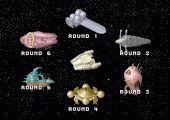
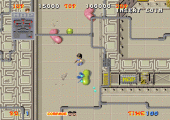
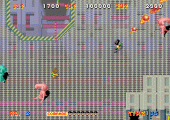
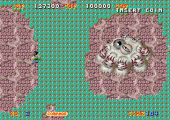
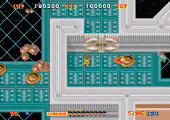
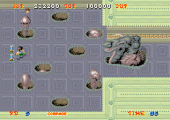
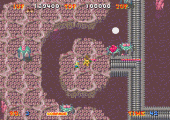
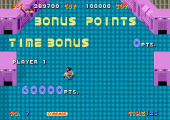

Recent Comments